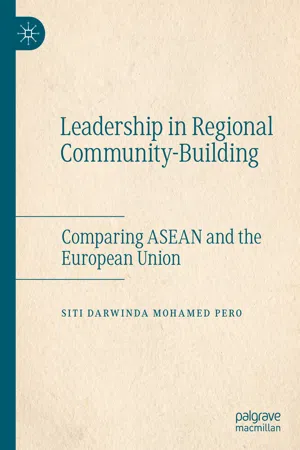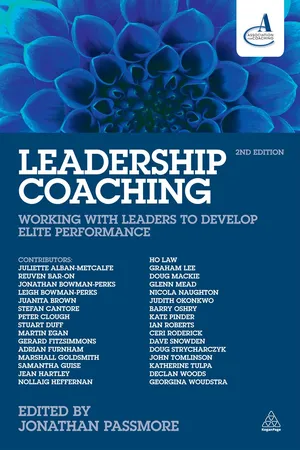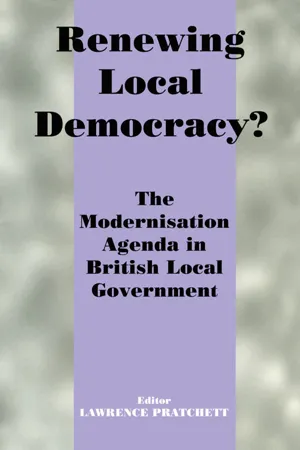Politics & International Relations
UK Political Leaders
UK political leaders refer to individuals who hold significant positions of power and influence within the United Kingdom's political system. This includes the Prime Minister, leaders of major political parties, and other key figures in government. These leaders play a crucial role in shaping and implementing policies, representing the country on the international stage, and making important decisions that impact the nation.
Written by Perlego with AI-assistance
Related key terms
3 Key excerpts on "UK Political Leaders"
- eBook - ePub
Leadership in Regional Community-Building
Comparing ASEAN and the European Union
- Siti Darwinda Mohamed Pero(Author)
- 2019(Publication Date)
- Palgrave Macmillan(Publisher)
The five explanatory factors enabled the researcher to determine the extent to which political leadership is always a main driver in the creation and maintenance of regional community-building efforts over time. The following section explains in detail the reconceptualisation of the notion of political leadership in a regional context based on five explanatory factors: political will, the capacity of the individual leaders, state capacity, legitimacy, and summitry.2.3 The Analytical Framework
Numerous definitions of political leadership exist (see, for example, Blondel 1987 , p. 3; Burns 1978 , p. 23; Paige 1977 , p. 1). Blondel (1987 , p. 3) defines political leadership as ‘the power exercised by one or a few individuals to direct members of the nation towards actions’. For Burns (1978 , p. 18), political leadership is a process of interaction of personal preferences , social influences , political motivations, job skills , and the structure of career possibilities. Paige (1977 , p. 1) has defined political leadership as ‘the behaviour of persons in position of political authority , their competitors, and these both in interaction with other member of societies as manifested in the past, present and probable future throughout the world’ (Paige 1977 , p. 1). According to Eckhard Lubkemeier (2007 cited in Schild 2010 , p. 1369), leadership is provided by ‘actors who are willing and capable, acting as co-leaders, to prompt other actors to contribute to the achievement of collective goals’.Building on these definitions, this book defines political leadership as a set of behaviours, actions, and decisions of an actor (at individual and/or state level) in a formal or informal position of authority who is willing and has the capacity to use the available power resources in such a way as to guide the behaviours of others towards a common goal , as well as in shaping a particular outcome . This definition suggests that leadership is a process of influence for ‘getting others to [do] what you want. … It co-opts people rather than coerce[s] them’ (Nye 2003 , p. 23). According to Hargrove (1998 , p. 2), ‘persuasion is the most effective approach to leadership than control’; persuasion is based on willing assent rather than coercion (Collins 2000 ). It is the process of mobilising the followers towards mutually constitutive objectives whereby leaders persuade followers that they, the initiators, are correct and should be supported (Burns 1978 ). Leaders, therefore, are required to have the courage and firm commitment to play leadership roles, setting the agenda and goals, as well as guiding the followers through the process using the art of influence. Such courage and commitment would most likely succeed when coupled with an elevated level of an individual leader’s personal capability to exert influence through shared ideas and agenda-settings, as well as the ‘hard power’ incentives offered by their respective country (Nye 2003 - eBook - ePub
Leadership Coaching
Working with Leaders to Develop Elite Performance
- Jonathan Passmore, Jonathan Passmore(Authors)
- 2015(Publication Date)
- Kogan Page(Publisher)
A political leadership booklet (Pinder and Hartley, 2005) provides a range of practical suggestions about how particular skills may be strengthened as well as short vignettes from a range of elected politicians about how they have improved their skills. It assists a politician with practical guidance on creating a personal development plan and also supports the idea that development can occur in a range of ways. The coach may refer to this in the coaching session(s).There is a substantial research base for the PLQ (Hartley, 2012; Hartley and Fletcher, 2007) in that it was piloted with 70 senior political leaders and then completed by a further 201 elected local politicians. Statistical analyses substantiated the model of contexts, challenges and capabilities. It has also been used in a major research project on local political leadership with 47 senior elected members from nine local authorities, where interviews and case study analysis were successfully triangulated and the model tested (Leach et al , 2005).Using the model with coachees
Political leadership is a serious business in numerical terms. There are about 130 ministers in the UK government (in both Houses), 650 MPs in the House of Commons and 780 peers in the House of Lords, plus around 200 elected members of the devolved parliaments and assemblies of the UK. At UK local government level, there are approximately 21,000 councillors in England, 1,223 in Scotland, 1,254 in Wales and 582 in Northern Ireland). There are 73 European Parliament members representing the UK regions. In the United States, at local government level alone, there are 89,055 local government units, including counties, municipalities, townships, school districts and other special districts that deal with issues such as fire protection. Adding state and federal-level politicians swells those numbers further.Furthermore, many politicians will be leading large organizations. For example, a UK secretary of state, such as the Home Secretary, has a budget of around £9 billion. They are also responsible for a staff of many thousands. At local authority level, the largest council has a staff of around 50,000 employees/contracted staff both full-time and part-time, with a billion-pound budget, while the smallest employs in the region of 82 staff. Public-sector organizations are indeed ‘big business’ (see also Hartley and Skelcher, 2008). - eBook - ePub
Renewing Local Democracy?
The Modernisation Agenda in British Local Government
- Lawrence Pratchett(Author)
- 2014(Publication Date)
- Routledge(Publisher)
The British leader by tradition lacks visibility and formal power. Rather than holding office, the leader heads the party group, and determines policy through the hierarchy of the political party and the control the party exercises over council business. The legal framework vests power in the elected council and its committees, so it is up to the political party and its leadership to organise council business and to ensure council officers follow its decisions. Leaders are selected by their party groups of councillors. They have to keep the group loyal or else it might vote into power another of its members. Leaders’ relationships outside the council are determined by the extent they can act authoritatively and win legitimacy rather than assuming a foreordained role. Some critics suggest the executive is headless and unaccountable because it is unclear who exercises power (see Young, 1994, for a summary of the debate). Other critics believe the leader is too weak and consensual, a tendency that has become more marked over time (Norton, 1978). This finding suggests that British leaders occupy the left-hand side of the quadrant of our table, particularly as, up until 2000, there has been no reform of the office in spite of the massive increase in workload and responsibilities. On the other hand, it is important not to underestimate the power of British leaders. They head large, powerful organisations and they are the most prominent democratically elected individuals in the local area. Moreover, they exercise these resources through relatively disciplined political parties. Indeed, British local politics has had many strong, even ruthless, local political leaders: T. Dan Smith of Newcastle in the 1960s, Herbert Morrison in London in the 1930s and 1940s (Donoughue and Jones, 1973) and John Bradock in Liverpool in the 1940s and 1950s (Baxter, 1972). While leaders became less colourful and powerful in the 1970s, resurgent local public figures emerged during the turbulent 1980s. On the left, there was Ken Livingstone in London, David Blunkett in Sheffield and Ted Knight in Lambeth; on the right, Lady Shirley Porter in Westminster and Paul Beresford in Wandsworth were also powerful and charismatic.
Index pages curate the most relevant extracts from our library of academic textbooks. They’ve been created using an in-house natural language model (NLM), each adding context and meaning to key research topics.


